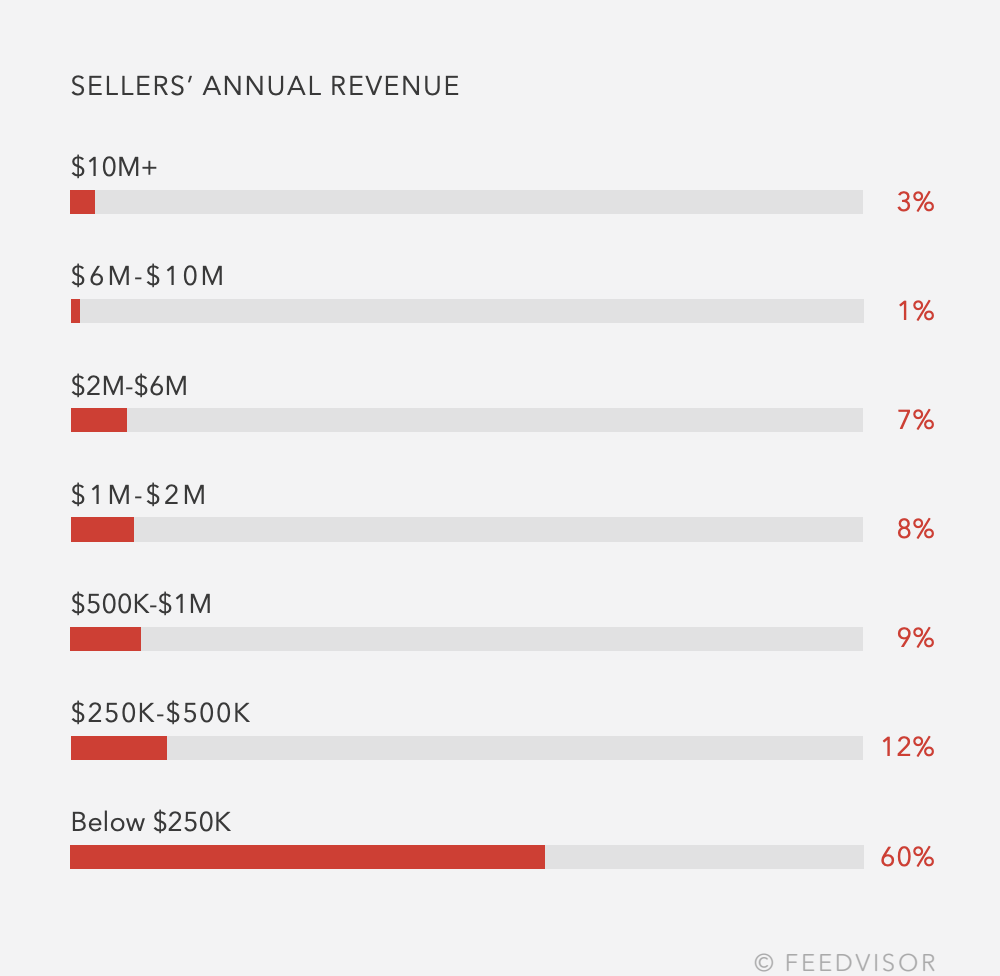REPORT FINDS 1 IN 5 AMAZON SELLERS SOLD OVER $1 MILLION WORTH OF PRODUCTS

“It’s too saturated.”
“It’s too competitive.”
“It’s nothing but a fad.”
We hear all kinds of reasons why becoming an online seller via Amazon is a waste of time. And ultimately, one of the biggest reservations that people have about selling on Amazon is not being able to turn a decent profit, let alone scale it into a full-time income.
It’s understandable. After all, every time you turn a corner, someone you know seems to be telling you they’re selling on Amazon. Your Facebook news feed is probably jam-packed with paid ads featuring online retail gurus who struck it rich and now want to show off their mansion and collection of fancy cars to any stranger they can reach.
If it seems too good to be true, it probably is, right? Maybe not…
We could sit here and argue about the viability of selling on Amazon until the cows come home. For every person you talk to about it, you’re probably going to get a different opinion.
Instead of telling you our personal opinions on the matter, we want to go in a different direction and let the data speak for itself. That’s right: There’s actual research proving that selling on Amazon can be immensely profitable. You don’t have to just take our word for it.
Let’s start with Feedvisor’s survey: The State of the Amazon Marketplace in 2018, which was based on survey results from 1,200 Amazon sellers. The results might surprise you — and even change your mind about pursuing a future as a seller on the marketplace giant.
1. More Sellers Are Making at Least $250K in Yearly Revenue
Let’s nip the myth that you can’t make money on Amazon in the bud because the survey results say otherwise.
In 2017, 28% of merchants made over $250K a year. In 2018, that increased to 40%. More specifically, million-dollar Amazon businesses are on the rise, growing by 9% in 2018.
It doesn’t end there, though. Multimillion-dollar sellers are seeing a boost too — from 1% in 2017 to 3% in 2018.
So, not only is there a substantial number of sellers making significant revenue, but that number is growing year over year. There is an increasing amount of room to be wildly successful in selling on Amazon. This is because although the number of people selling on Amazon is growing, at the same time, so is the demand. More and more people are shopping on Amazon than ever before. It’s the biggest online retailer in the country, and it makes up a whopping 50% of e-commerce growth.
The number of sellers can’t keep up with the demand. That’s how quickly Amazon is expanding.
Here’s how the survey broke down revenue:

With all of the money being made here, don’t you think there’s room for you? We sure do.
2. More Sellers Are Expanding Beyond the United States
Another pesky myth is that selling outside of your own country requires too much hoop-jumping and additional costs. Is there a learning curve? Sure. Might it take extra effort on your part? Probably.
Is there real money to be made? Without a doubt.
Online retail knows no geographical boundaries, and Amazon sellers are proof of that. According to Feedvisor’s survey, 37% of sellers said they were already selling outside of the United States, and an additional 26% said they planned to expand internationally throughout 2018. In 2019, the number of sellers going international increased to 45%!
This is one of the best parts of running an online business. You’re not confined by state lines or even country borders. There are no limits, no boundaries. If you want to, you can grow your business as big and as far as you’d like.
Isn’t that one of the reasons we want to ditch our 9-5s and start our businesses — to determine how much money we can make? This isn’t something you can get from any employer, who has total control over your paycheck.
You can stay domestic if you want — and still make an insane living, by the way. But just think of the possibilities when you can sell to the entire online world.
3. FBA is the Way to Go
Understandably, aspiring sellers sometimes express concern regarding the fees associated with selling FBA. Yes, Amazon offers to handle tedious and time-consuming tasks like packaging, shipping, and all matters of customer service, like returns, refunds, and replacements. In exchange, they take a cut of your sales.
But is it worth the additional cost? Wouldn’t it ultimately be cheaper to manage everything yourself? The survey says no.
Don’t get us wrong: FBM certainly has its advantages, and under some circumstances, it’s the better of the two approaches. For instance, it offers you more control over your inventory, since you’re never sending it off to Amazon’s warehouses so that they can take over from there.
However, the survey reveals that in terms of revenue, FBA is where it’s at. Looking specifically at profit margins above 11%, sellers that are over 60% FBA always beat out sellers that are mostly FBM. Around 33% of sellers who were at least 60% FBA experienced a 21-30% profit margin. Only 25% of FBM sellers could say the same.
This tells us that while, yes, FBA means an additional cost to the seller, the benefits far outweigh that cost. It was a popular approach in 2018 and continued to dominate in 2019.
Clearly, there’s no doubt that you can sell on Amazon not just as a casual side hustle (although that’s totally okay) but as a lucrative, full-time income. The next question, then, is how?
It’s in your best interest to find an approach that requires the least risk but still offers a big reward. Private label demands a hefty upfront investment, so if it fails (which happens to some sellers, let’s face it), you’re out quite a bit of money.
Dropshipping is unstable, and Amazon is not a fan of drop shippers. It’s not a logical long-term approach.
Retail and online arbitrage are both difficult to scale. Stores and brands are catching onto resellers and starting to limit how many units of one product you can buy. Similar to dropshipping, this won’t be feasible in the long run.
But there is an option that can work for you: wholesale.
Wholesale excels where all of the other methods of online selling fall short. Because there’s a formula for finding products that are already winning, it requires far less risk on your part.
Plus, you’re forming long-term relationships with distributors and manufacturers, meaning you might be working with them for years at a time to sell their products on Amazon.
There are a lot of people out there teaching a lot of different ways to sell on Amazon. Very few of these people, however, can prove that their methods work.
The Wholesale Formula has countless success stories — people whose lives have changed as a result of following our strategy for selling wholesale on Amazon. It worked for them, and it can work for you too.
